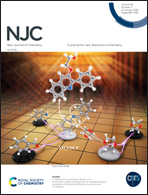Coordination behaviour of a hybrid phosphinoguanidine ligand†
Abstract
This contribution focuses on the coordination behaviour of 2-[2-(diphenylphosphino)phenyl]-1,3-diisopropylguanidine (1), which is a representative of the unique P,N-ligands combining phosphine moieties with strongly basic guanidinium substituents. This compound was prepared by the reaction of 2-(diphenylphosphino)aniline with 1,3-diisopropylcarbodiimide in the presence of diethylzinc (10 mol%). When mixed with [MCl2L2] (M = Pd, Pt; L = a weakly bonding ligand), ligand 1 gives rise to P,N-chelate complexes [MCl2(1-κ2P,N)]. However, in the case of kinetically inert Pt(II), the products of partial substitution and chloride ionisation, [PtCl(1-κ2P,N)(L)]Cl, where L = Me2SO or η2-cycloocta-1,5-diene, can be intercepted. Ionisation also occurs in the reaction with [PdCl(η3-C3H5)]2, leading to [Pd(η3-C3H5)(1-κ2P,N)]Cl, while [Pd(MeCN)4][BF4]2 produces the bis-chelate complex, cis-[Pd(1-κ2P,N)2][BF4]2. In contrast, the corresponding hydrochloride (1H)Cl behaves as a simple phosphine, reacting with PdCl2 surrogates to give the zwitterionic species [PdCl3(1H-κP)] and the bis-phosphine complex trans-[PdCl2(1H-κP)2]Cl2, depending on the metal-to-ligand ratio.



 Please wait while we load your content...
Please wait while we load your content...